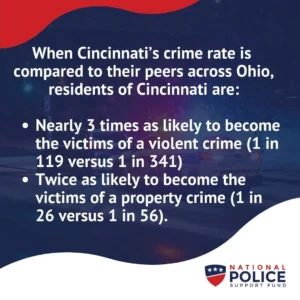According to FBI crime data, the city of Cincinnati is now the 33rd most dangerous city in the United States – not only due to its relatively high incidence of violent crime but also due to its high cost of crime per capita.
This metric examines the economic impact of crime on a city’s economy per resident. The results indicate that in Cincinnati, residents lose much more money directly from crime while recovering from it or trying to protect themselves from it.
How Unsafe is Cincinnati?
Quantifying the impact of crime is never easy. Absolute numbers only ever tell half the story. Instead, researchers need to look at which crimes are being committed: generally speaking, car thefts create a different societal problem than home invasions or homicides. This also needs to be compared against the total population size and the likelihood of criminals seeing due justice.
Combined, these three factors will determine how likely each citizen is to become the victim of crime and how protected they feel by the institutions around them.
In this sense, Cincinnati has seen its picture darken progressively over the past 100 years. As of last year, the City of Cincinnati had:
- 30 homicides for every 100,000 people
- Over 1,000 registered sex offenders
- A violent crime rate of 8.39 per 1,000 residents
- A property crime rate of 37.95 per 1,000 residents
- An average of 180 crimes per square mile.
Naturally, the incidence of crime is not distributed equally. While this city doesn’t experience the same sharp contrasts as Chicago or St Louis, the map does show a clear pattern: the most dangerous neighborhoods are in the Southwestern side of the city, especially along the river.

A few of the most common appearances in crime stories are the neighborhoods of Lower Price Hill, Sedamsville, and East Price Hill. The city’s downtown districts (including Downtown North, Over-the-Rhine, and Laurel Park) also inspire wariness among locals.
How does this compare with the rest of the state of Ohio?
Crime rates in Ohio are usually topped by its three largest cities: Cleveland, Cincinnati, and Columbus. All three cities have higher crime rates than the state’s suburban and rural areas – but overall, the state ranks closer to the bottom regarding danger.
Cincinnati’s crime rate currently dwarfs Columbus’s, although the city remains decidedly safer than Cleveland. When compared to their peers across the State, residents of Cincinnati are:
- Nearly three times as likely to become the victims of a violent crime (1 in 119 vs 1 in 341)
- Twice as likely to become the victims of a property crime (1 in 26 vs 1 in 56).
What Can We Do to Make Cincinnati Safer?
At some point over the last decade, Cincinnati was lauded for its work revitalizing one of the nation’s most dangerous neighborhoods – the area known as “Over-the-Rhine.” Between 2011 and 2016, this area went from a gang-controlled hotspot to an up-and-coming borough full of trendy restaurants.
However, a private company, the Cincinnati Center City Development Corporation, largely planned this revitalization. Being a private company may have given them much leeway when it came to rescuing buildings, but it didn’t include coordination with local law enforcement,
As the city’s police department remained understaffed, it was easy prey to the generalized post-pandemic crime surge. Until recruitment numbers improve, the city will continue facing an uphill battle against its criminals.








